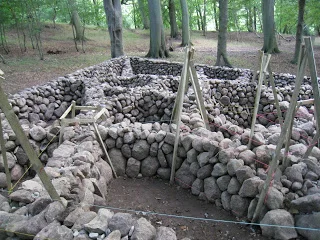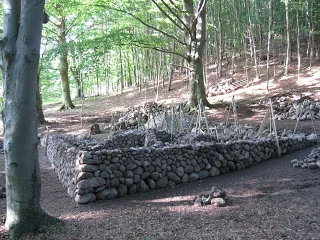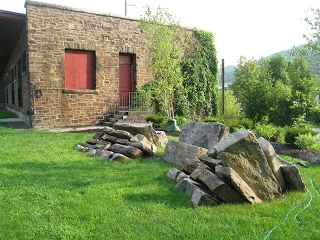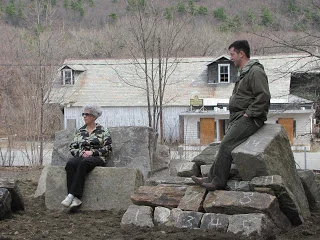This song, from Mark Knopfler and Emmylou Harris’s “All the Roadrunning” album, makes a good anthem for those of us who grub our living out of the ground. We stone workers labor to lift something special from the earth. Our efforts are mainly brutish and blunt but we continue day by day in the belief that something beautiful will arise in the end. When it finally does, the light of what we’ve created shines briefly before for us. And then we must turn our backs and leave it all behind.
Read MoreAbout once an hour, or so, someone walks by the site and asks me what I’m doing. Often they wonder if I am repairing something. I’ve been told the piece looks like a temple, fishponds, and human tissue under a microscope. “How long before it’s finished?” and, “What’s it called?” are the common follow-up questions after they hear I’m building a new abstract sculpture for TICKON art-park. I can now say that it will be finished in a few days, and that the piece is called “The Diamond Mines.” It’s been a rare experience for me; spending these past weeks in a grove of stately old beach trees. Plus, daily visits from Elin, and picnics with her Danish family, have quickly turned this project into an all-time personal favorite.
Read MoreWorking hands inform thought and awaken understanding of the art builder's place in the natural world. Undulant lines and patterned spaces are the result of many choices made by the art builder who recognizes, and utilizes, the unique character of stone. The presentation will examine the many uses of stone in art; how stone can support a design, or simply be the art itself. It will also explore the "give and take" experience of working in nature, and the connection to spirit expressed through stone.
Read MoreSculptor Markku “The General” Hakuri marshaled a merry band of art lovers in the destruction of the pieces he exhibited in the Kerava Art Museum this summer. The closing ceremony of the show included a parade of dismantled sculpture parts and their burning in a bonfire. After the fire died down we proceeded to tumble my sculpture “Wishing Wells”. From its conception, my piece was destined to be removed at the end of the show, so, we had a fun time pulling out stones and watching the well walls cascade to the ground. Most delightful was the musical sound made by the downpour of cobbles.
Read MoreThe TICKON installation is past the halfway mark thanks to the help of Alfio Bonnano and Ole Johnsen who have coordinated all the logistics of tools and materials, plus, made us feel at home away from home. On site, Francesca and Jared have put in long hours raising the walls of the piece that will soon be the newest addition to the art park. Elin has been busy orchestrating the myriad details of working and living away from Vermont, and documenting the process and progress of the installation.
Read MoreIt took me a few days to ‘get’ TICKON’s method of operation but I can now appreciate it for its full value. The art park owns no tools or equipment. Everything needed to produce a new installation is gathered piecemeal from community members in the surrounding villages. So, for the first few days of my project I rode around the countryside with Ole each morning popping in on local folk to have a chat. We explained what the project was, and what we were looking for. Eventually the tools and materials came together. In the process, more and more people became involved in the project. They have helped to create a new art work at TICKON. “Mange tak” to all those who have made me feel welcome in the Kommune of Langeland.
Read MoreWhile the supply was drying out I began setting up batter frames. Each board describes an inside corner of the construction. Because the wall intersections are many different obtuse and acute angles, each board is set to correspond to the intersection angle and to the wall batter. The wall batter is 2.5” in every 12” of vertical height. Work on the piece begins at the center and moves out toward the perimeter as progress is made over the next few weeks.
Read MoreFrom the glacier fed streams of Norway’s Jotunheimen mountains, I’ve traveled this past week to the low, wetlands of Denmark. In fact, I’m living in a 300 year-old house alongside a castle moat. This is the artist’s residence for TICKON, the environmental art park I’ll be working in for the next month. Yesterday 20 tons of stone was gathered from field piles and delivered by the tractor-wagon load to the site of my construction. Today the outline of the work will be established and guide frames erected.
Read MoreDuring my working life I’ve shifted freely, back and forth, from artist to dry stone waller. Whatever the final outcome of any work, it’s been the making that I’ve liked the best. With ‘Rock Rest’, I enjoyed the creative process so much that I built the piece twice; once in my Dummerston stone yard and once here beside the museum. The stone was initially collected from a steep slope on a wooded property in Townshend. It lay there for twelve thousand years after being plucked from the ledges by the last ice age. In ‘Rock Rest’ I’ve attempted to simulate the natural process that turns bedrock into loose stone. I’ve always been fascinated by the way stones separate from one another but lock more tightly together as they slide apart.
Read MoreThe road to a project’s completion is often a long and winding one. That’s why it’s worth taking time along the way to enjoy the view. The installation I’ll be doing at TICKON in Denmark later this summer began last year with an invitation from the art park to submit a proposal. Over the months, conversations and emails have taken the proposal through a series of development where I now feel that all the parts are in place to begin the work.
Read MoreMy interview on Vermont Public Radio is airing at noon today - most likely after the segment on under-age drinking parties.
Jane Lindholm visited me at work in Dummerston last week for a feature on this month's installment in Vermont Edition's "Visiting Artists" series. Click on VPR's Vermont Edition for more info.
Read MoreThe trees in the parks of Helsinki were beginning to show signs of awakening from their winter sleep when I arrived here early May. Today, my last day in Finland on this trip, they are flush with lush green leaves. I leave behind good friends, old and new. It’s been an exciting few weeks of city life. The Kerava Art Museum exhibition is now open to the public until August 28 when the artist’s pieces will be dismantled and moved, or recycled. I’m pleased with the way my two works came out. ‘L.E.M.’ is the small stone and steel construction displayed inside the museum in partnership with Tristan Hamel’s silk-paper globe. Outside, ‘Wishing Wells’ invites museum-goers and passer-by’s to walk through and around its canyons and cavities.
Read MoreBelow is the gist of my presentation for the artist’s seminar that preceded the opening of the show at Kerava Art Museum yesterday. The title and theme for this exhibition is ‘Hole in the Universe’. I don’t know how it sounds in Finnish but the word ‘hole’, in English, can be heard as ‘whole’; with a ‘w’. So the title, when spoken, can be interpreted in two ways. Both are interesting concepts to ponder, and respond to by making art. A hole can be a void, a container or a passage way. To become whole in the universe, complete in mind, body and soul, is perhaps the ultimate artists’ quest.
Read MoreThe techniques used to set stones in relation to one another can be varied. The sizes and shapes of the stones in any supply are often the final determining factor in the design of a dry stone structure. The supply limits the possibilities, focusing the process of design on what is doable. Limits actually increase the potential for a successful outcome. By first assessing the qualities of the available stone, a more ornamental or contemporary design might be considered and pursued.
Read MoreThe exhibition, brought to being by sculptor and professor of Environmental Art Markku Hakuri, focuses on the human and the surrounding universe poetically through surprising spatial experiences. On this trip Hakuri has invited his colleagues, renowned environmental artists Juliane Stiegele from Germany, Daniel Snow from the United States and Michal Cimala from the Czech Republic. A Hole in the Universe is born when the world is nudged off its usual orbit and when it is time to see and understand differently.
Read MoreThe first full day of sculpture making at Kerava Art Museum brought one form to completion. Because this is a temporary exhibit, I’m building directly on the lawn grass. The granite pebbles and cobbles are easy to handle and a nice change of pace from heavy lifting, even though I do have to spend most of the day on my knees. Their smoothness makes them a bit slippery. I wouldn’t recommend using them this way for a permanent construction. This type of arrangement is like making a big ring cake out of small potatoes. Thanks to students Lauri, Hannah and Iisa for set-up assistance. And to Jenni M. for stone shifting.
Read MoreYesterday, Professor Markku Hakuri took me for a train and bus ride to check out the site for my installation at the Kerava Art Museum. This morning I went ten miles outside of Helsinki to a look at gravel pit. A ‘tailings’ pile I found there has the right ingredients for making a piece that combines twelve hollow cones into a mound shape. Because a group of university art students will be helping me, it’s important that the stones be easily shifted and lifted by hand, and the cones and mound be definable with lines and guide frames. This afternoon I made a 3-D sketch in clay of the design I’ve been working on in my head for the past couple of days.
Read MoreThree days this week were devoted to dismantling and reassembling a sculpture titled ‘Rock Rest’. The piece was designed and constructed last December at my stone yard with the intention that it would eventually be installed at the Brattleboro Museum and Art Center’s new sculpture garden. On Sunday I numbered and catalogued the 50+ stones in the piece and transported them, by five truck and trailer loads, seven miles to Brattleboro. The stones were spread out across the parking lot in preparation for placement in the piece.
Read More
















